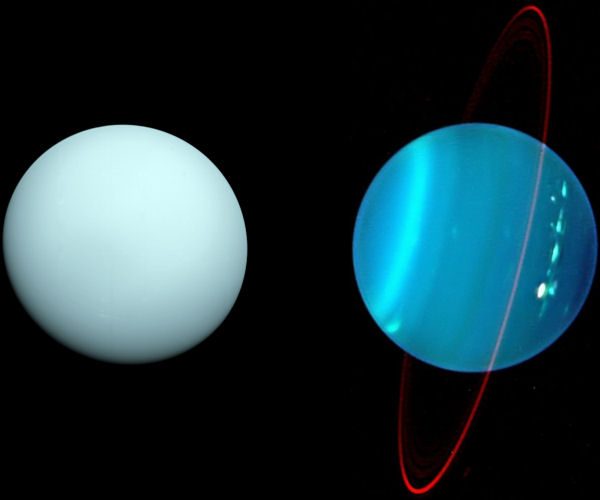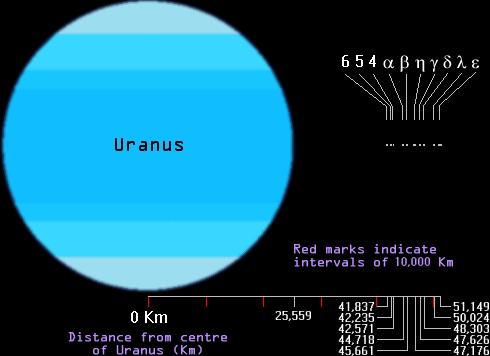Uranus
![]()
Of all the planets in the Solar System, Uranus stands out as the only one to possess an axial tilt of 97.86°, which means that the polar regions of the planet face the Sun for several years at a time. Consequently, Uranus experiences the longest seasons of any planet in the Solar System. The image below, taken by the Hubble Space Telescope in 1996, illustrates the hazy (and normally featureless) atmosphere along with Uranus' most prominent rings and a few satellites.

Uranus as imaged by Voyager 2 in visible light (left)
and by the Keck Observatory in near-infrared (right)
[ NASA / JPL / Caltech ]
| Siderial Period |
Perihelion (AU) |
Aphelion (AU) |
Inclination (degrees) |
Axial Tilt (deg) |
Axial Period (d, h, m) |
|---|---|---|---|---|---|
| 84.01 y | 18.31 | 20.07 | 0.8 | 97.86 | 0, 15, 36.0, R |
| Equatorial Diameter (km) |
Oblateness | Mass (Earth = 1) |
Density (water = 1) |
Albedo (geom.) |
No. of Satellites |
| 51, 119 | 0.030 | 14.50 | 1.3 | 0.51 | 17 + R |
Ring system
Uranus' ring system is divided into 11 thin, dark rings. The cross-section below illustrates the ring system to scale (in terms of radial distance from the centre of Neptune). The ring system was discovered by accident on 10th March 1977, when Uranus occulted a star. Scientists planned to measure the diameter of Uranus accurately and also obtain data on its upper atmosphere. James Elliott and colleagues observed the event from high altitude in a NASA plane, and noticed the star blink several times shortly before and after the occultation. (Kaufmann, 1994.) It was clear that Uranus possessed a system of rings, and because of Uranus's unique 97.86° axial tilt, it was highly likely that the rings would be detected if they were present (because at the time, the full face of the ring system was directed towards Earth). (Diagram based on data from the NSSDC.)

Rings 6, 5, 4, h and l average about 2 Km in width. The other rings' widths are listed below.
![]() a
: 4 - 10 Km
a
: 4 - 10 Km
![]() b
: 5 - 11 Km
b
: 5 - 11 Km
![]() g
: 1 - 4 Km
g
: 1 - 4 Km
![]() d
: 3 - 7 Km
d
: 3 - 7 Km
![]() e
: 20 - 96 Km
e
: 20 - 96 Km
Of all of Uranus' satellites, only Cordelia orbits at distances similar to those of the rings, at around 50,000 Km from the centre of the planet. This is clearly within 2 radii of the centre of Uranus, and therefore well within its Roche limit. The fact that Cordelia is a small body only 26 Km across may account for why it remains a whole body and has not been torn apart by tidal forces. In addition, it must have a reasonably high tensile strength.
Missions to Uranus
For a list of missions to Uranus see the links page.